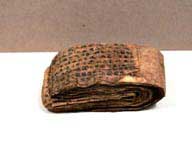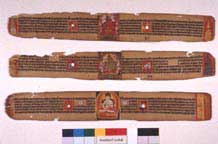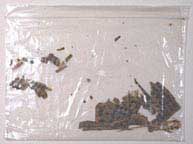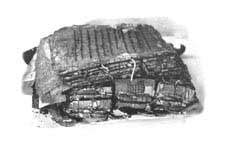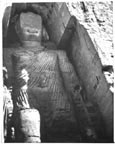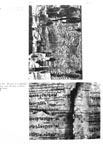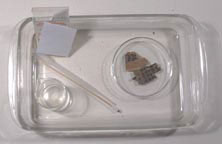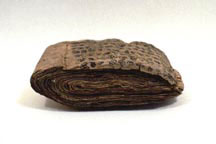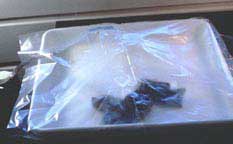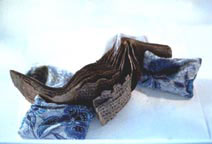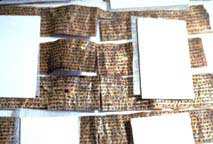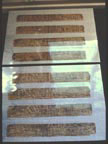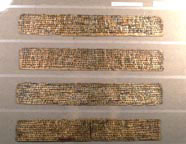Mirror: http://tinyurl.com/nzmy7bv
Comparable to the archaeometallurgical challenge of delineating the Maritime Tin Route linking Hanoi and Haifa is the epigraphical challenge of tracing the roots of Kharoṣṭhī and Brahmi scripts which signify Prakritam language speech syllables (together with Indus Script words of Proto-Prakritam) on artifacts such as Asoka edicts, punch-marked/cast coins, Sohgaura copper plate, Rampurva Asoka pillar copper bolt.
Indus Script signified Proto-Prakritam words of metalwork; Kharoṣṭhī and Brahmi scripts signified syllables of Prakritam speech (parole).
Indus Script hieroglyphs (ca. 500 signs on text + ca. 100 pictorial motifs on artifacts of seals, tablets, etc.) are rebus-metonymy layers of words from Meluhha (Proto-Prakritam) lexis of metalwork.
Kharoṣṭhī and Brahmi scripts deployed together with Indus Script hieroglyphs, for example, on punch-marked coins identified by W. Theobald signified syllabic pronunciation of names of janapadas or guild-masters of mints or rulers. Hieroglyphs such as tree-on-railing, svastika, elephant, tiger, fishes, crocodile snatching fish in its jaws, mountain-ranges continue to be used on early punch-marked coins to signify metalwork catalogues, following the Indus Script tradition of using the hieroglyph-multiplexes to signify technical specifications of metalwork or metalcastings in mints.
See:
http://bharatkalyan97.blogspot.in/2015/06/an-object-lesson-for-art-historians.html
http://bharatkalyan97.blogspot.in/2015/07/nature-of-indus-writing-system-defined.html
http://bharatkalyan97.blogspot.in/2015/08/itihasa-of-bharatam-janam-traced-from.html
http://bharatkalyan97.blogspot.in/2014/10/indus-script-hieroglyphs-continued-use.html
Coin of Gurgamoya, king of Khotan. Khotan, 1st century CE.
Obverse: Kharoṣṭhī legend: "Of the great king of kings, king of Khotan, Gurgamoya. Reverse: Chinese legend: "Twenty-four grain copper coin."
![]()
Source: https://en.wikipedia.org/wiki/Kharosthi#/media/File:KingGurgamoyaKhotan1stCenturyCE.jpg
cf.
Salomon, Richard. Kharoṣṭhī syllables used as location markers in Gāndhāran stūpa architecture. Pierfrancesco Callieri, ed., Architetti, Capomastri, Artigiani: L’organizzazione dei cantieri e della produzione artistica nell’asia ellenistica. Studi offerti a Domenico Faccenna nel suo ottantesimo compleanno. (Serie Orientale Rome 100; Rome: Istituto Italiano per l’Africa e l’Oriente, 2006), pp. 181–224.
![]()
![]()
![]()
![Bark text fragment]()
A fragment of Buddha's teachings - AP picture (computer enhanced)
The Project
In the fall of 1998, a professional numismatist, with a specialty in Classical antiquity, brought an early manuscript to my studio for consultation. (Fig.1) The elongated leaves were brittle, compressed together, water damaged, and folded into a tight "S" curve, like a wad of dollar bills after the wash cycle. This manuscript was found in the Bhamiyan cave region in modern Afghanistan, purportedly from the 5th century, on birch bark, and written in the Kharoṣṭhī script.
The owner's hope was that the manuscript leaves could be opened and separated, in order to be translated. He explained to me that this manuscript was extremely rare, and that the owner hoped to discover any missing links to the history of early Buddhism.
Ethical ConsiderationsBut before agreeing to take this project on, I had several philosophical and ethical questions. I am familiar with many types of Asian books and manuscripts; and have considerable experience examining and treating early Buddhist sutras on paper & Indian palm-leaf manuscripts. (Fig. 2) These Indian and Himalayan manuscript types provoke inquiry and ethical considerations, especially issues regarding the treatment of sacred objects. As with most ethical questions, there are a wide variety of answers, depending on the opinions of religious and museum specialists.
When Buddhist sutras are found inside sculptures, conservators and curators often disagree on the appropriateness of removing these rolled-up documents from their consecrated compartments and treating them individually as works on paper. Additionally, some published accounts insist on the importance of having a religious official re-consecrate the sutras prior to insertion back into the sculptural cavity.
Indian palm-leaf manuscripts present fewer ethical problems for the conservator, as they are often collected individually for their illustrated images, and many beautiful examples exist in museums, libraries, and private collections. Palm leaf manuscripts were probably in use as early as the 2nd century, but no extant leaves survive earlier than the 10th century. Because palm-leaf is still used today in India for certain religious writings, much is known about the manufacture and treatment of the material.
Birch Bark
But what about birch bark? Prior to the day last fall when I first examined this manuscript, I was completely unfamiliar with the material as a support for writing. Admitting this to the client in our initial meeting, I took several slides, and was given a small bag of manuscript fragments (Fig. 3) in order to begin research and testing on an appropriate treatment methodology. To be honest, I didn't have very high hopes, and, as I talked to colleagues about the project -- I couldn't find anyone else in conservation familiar with this type of early manuscript. I was anxious about treating this object for many reasons: the object was purportedly from the 5th century, it might be a missing link to the history of Buddhism, and it was also extremely valuable. So, research and testing had to resolve whether this treatment would provide the desired results.
Initial research
Before commencing a literature survey, I consulted several colleagues who had great experience with manuscripts, early non-paper collections, and Indian art in general. Colleagues familiar with papyrus were particularly helpful, and other colleagues tried to convince me that the manuscript must be on palm-leaf, which was my initial error as well. A particularly helpful consultation was with Nancy Turner, Manuscript Conservator at the J Paul Getty Museum. I brought my slides and my fragments up to her lab, and we examined them under the microscope, and they were, in fact, bark. We could clearly see the laminated layers of very thin barks and examine the inks and written inscriptions very clearly.
The literature survey was sparse but useful, with a great deal of historical data, but little information on conservation treatment.
History of birch bark as a material for writing
(Fig. 4) The research in Butterworth's Conservation of Manuscripts and Paintings of South-East Asia, revealed that birch-bark (called bhoja-patra) was a primary writing material along with palm-leaf in India before paper. Birch bark was mentioned as a writing material by the Greek historian Q. Curtius, noting its wide use during Alexander's invasion by Hindus. Early extant manuscripts date to the 2nd and 3rd centuries, written in the Kharoṣṭhī script. Fragments survive from a range of time periods, and the material is described throughout Indian literature. Bhoja-Patra's use diminished in the Mughal period when paper replaced it as a writing material, but it still has a sacred status in India today.
Despite its status as a sacred material, all of the literature focused on bhoja-patra's use as a support for writing. Buddhist sutras were written by monks, and often sponsored by donors, who might be high lamas or officials. The manuscripts are not illustrated and have no history of association with consecrated sculptures or images. Bhoja-patras were literally the Ancient database of Buddhism in India.
Gandhara
The manuscript brought to my studio, now called the "Los Angeles manuscript" was found in the Bamiyan cave region of modern Afghanistan. In ancient times, this area was part of Gandhara, the region invaded by Alexander the Great in 326 BCE. Gandhara became a second Holy Land of Buddhism, and most extant sculpture from the region took the form of Buddhist cult objects, Buddhas and Boddhisattvas, (Fig. 5) like this Boddhisattva sculpture from the 3rd century in the Norton Simon Museum, or architectural ornament of Buddhist monasteries. Because of the strong influence of the Greeks and Romans, Gandaran sculpture reveals many Western classical elements, including the treatment of the robe and its heavy folds, and the physiognomy of the central figure. Interaction through caravan trade routes and the Silk Route in particular maintained these stylistic exchanges.
Bamiyan Caves
One of the greatest sites in Gandhara is Bamiyan, a mountain valley in north-central Afghanistan. (Fig. 6) A high cliff forms one side of the valley and is honeycombed with monastic dwellings, bounded on either side by colossal Buddhas in niches cut out of the rock. The largest, depicted here, is 174 feet high, and in the Gandharan style. (Fig. 7) The region is full of monasteries, stupas, and caves, some with rich interior depositories of paintings, murals, and manuscripts.
In the studio
The literature states that the inner bark of the birch tree was used for writing. (Fig. 8) After being peeled off the tree, the bark was dried. Oil was then applied over it and it was polished. Layers were joined together by a natural gum. Finally it was cut to a suitable size and kept in between wooden covers. The ink used for writing on birch bark was "Indian black, a carbon ink. It was prepared by burning almond shells to charcoal, which was then boiled with cow's urine. This ink is said to have a special brilliance and is fast to washing." Tests have shown birch bark sheets to be typically 0.2 - 0.5 mm thick, and contain a cellulose content of 38%. Additionally, birch bark is highly soluble in organic solvents, but not soluble in cold water.
Initial research complete, I began to test the fragments in the studio. (Fig. 9) The inks proved stable, as predicted in the literature, and the birch bark itself became supple in high humidity and contact with water, without staining. Bolstered by these results, I agreed to take on the project.
Treatment
Once we had the manuscript in the studio, we began detailed written and photographic documentation prior to treatment. (Fig. 10) I had decided to use humidity to attempt to open, separate, and flatten the leaves. But before I describe the steps employed, I would like to read the only historical account I could find in the literature for separation.
It reads:
The Conservation Treatment
Since the inks were stable, and the bark impervious to water staining, I began humidifying the manuscript using an ultrasonic humidification chamber made from a photo tray and plastic sheeting and maintaining 80% relative humidity (RH). (Fig. 11) While watching carefully for excess precipitation, the manuscript underwent humidification in this fashion for several days. To my great satisfaction, the leaves began to relax, but were not wet. I continued to humidify the manuscript in this fashion for another 72 or more hours, which allowed me to begin carefully manipulating the "block".
As you can see, I was able to begin to open the entire manuscript from its tight "S" configuration to a looser shape. (Fig. 12) Maintaining a minimum of 70 - 80% RH, the entire block not only began to open, but the outer leaves began to separate as well. (Fig 13) Soon I was able to begin separating the outer most leaves with the mechanical aid of a Teflon coated microspatula and removing them completely from the block. Despite all of this humidification, the leaves were still extremely brittle and fragile, and great care had to be employed. Also -- most leaves were split down the center, and had many other fractures and loose attachments. At many times in this project, more than one pair of hands and eyes were needed, both to handle the delicate leaves, and double check accurate collation of a manuscript in a non-Roman alphabet.
Once the first group of 6 outer leaves were removed, they were placed on a damp blotter and Gore-Tex layer, and gently held in place until the top of the "blotter sandwich" could be placed on top. Needless to say, this first group's successful separation was extremely exciting around the studio, and I called the owner with the initial good news.
We continued the treatment, and subsequent leaves also separated in this fashion, followed by further humidification once flat, followed by flattening between dry cotton waterleaf blotters. In the end, the leaves opened up to approximately 2 inches high by 14 inches wide, from the original 2 x 3 inch folded object.
Presentation
Since the goal of this project was translation of the manuscript(s), I recommended Mylar encapsulation without repair of the individual leaves. This way, the leaves would remain flat and could be handled, and there would not be any repair tissues obscuring any text. We designed a 14 x 18" Mylar package, dividing each sheet into four rows to accommodate the manuscript leaves. Each package contained two Mylar sheets and horizontal rows of double stick tape. (Fig 14) The bottom Mylar sheet was clamped to the work table, and, working together, we would bring over each manuscript leaf one at a time, in order; lift the tape paper, and seal down the "row" to lock in the leaf. I was so afraid of losing the order or flipping the leaves, since I don't read Kharoṣṭhī or Sanskrit, that we were extremely careful about collation.
SuccessIn the end, the treatment was a great success. (Fig. 15) All of the leaves separated, and remained flat in their encapsulated packages. There were fragments and areas of birch-bark leaf loss, just like any ancient material like papyrus, but all the scraps and fragments were saved and encapsulated in the precise order of the original folded object.
Translation
After the final meeting with the very pleased owner, and the work was released from the studio, the manuscript was taken away for translation. After being photographed, transparencies were sent to Richard Salomon, the author of Ancient Buddhist Scrolls from Gandhara, a publication of the British Library. This book came out in June 1999, six months after my research and treatment. In the book, Mr. Saloman states:
After Mr. Saloman's initial consultation, it was sent to Dr. Gregory Schopen at UCLA, who translated the manuscript. This was the result: the 40-odd leaves or fragments were two complete books, or texts, and the technical name for the script is "upright Calligraphic Gupta". The larger text was a previously known Buddhist sutra and the equivalent of 37-40 leaves. The transliteration and translation were sent to me along with the information that the "smaller of the two books, which Dr. Schopen has dubbed the "Los Angeles Manuscript", consists of a seven page incantation apparently unknown in contemporary manuscripts and thus of significantly more interest to scholars." This manuscript is now in the process of being published by Dr. Schopen, and is every bit the "missing link" to history as the owner had hoped.
I would like to thank the many colleagues and associates who assisted me in my research and treatment, and in the preparation of this paper. In particular, thanks to aNancy Turner, Manuscript Conservator at the J. Paul Getty Museum, for her consultation, and my studio associate Micol Hebron. In addition, I would like to thank Dr. Page duBois, Professor of Classical Studies and Comparative Literature at UC San Diego, Indian art specialists Christine Knoke at the Norton Simon Museum and Dr. Stephen Little at the Art Institute of Chicago, and the LACMA Conservation Center for use of their library and resources.
Susan Sayre Batton
Art Conservation & Consulting Services
Los Angeles, California
suesayre@aol.com
Agrawal, O.P., Conservation of Manuscripts of Southeast Asia.
Butterworth.
Agrawal,. O.P., "Investigations for preservation of birch-bark manuscripts",
Preprints of ICOM Committee for Conservation, Vith Triennial Meeting, Ottawa (1981) Paper.
Filliozat, Jean, "Manuscripts on birch-bark (Bhurja patra) and their
preservation", The Indian Archives, 1 (1947) 102-8
Harle, J.C., The Art and Architecture of the Indian Subcontinent.
Penguin Books.
![]() Cave 16 at the Mogao caves showing the entrance to cave 17 to the right. Stein's original image of this scene was double exposed and he therefore recreated it by drawing the manuscripts onto the negative of an image showing an empty Cave 16. Serindia Fig. 200, c. 1905. Photo 392/59(1) & Photo 392/59(2)
Cave 16 at the Mogao caves showing the entrance to cave 17 to the right. Stein's original image of this scene was double exposed and he therefore recreated it by drawing the manuscripts onto the negative of an image showing an empty Cave 16. Serindia Fig. 200, c. 1905. Photo 392/59(1) & Photo 392/59(2)
![Bronze reliquary and Kushan coins from a Buddhist relic deposit]()
![]()
Fig .: Karoshthī font
Tocharian font
![]()
Fig .: Tocharian font![]()
Fig .: wooden tablets with Tocharian Scripture Kucha (庫車), China, 5 /. 8 Century AD..
[Source: Wikipedia]
http://www.payer.de/exegese/exeg03.htm#5.2.1.
Comparable to the archaeometallurgical challenge of delineating the Maritime Tin Route linking Hanoi and Haifa is the epigraphical challenge of tracing the roots of Kharoṣṭhī and Brahmi scripts which signify Prakritam language speech syllables (together with Indus Script words of Proto-Prakritam) on artifacts such as Asoka edicts, punch-marked/cast coins, Sohgaura copper plate, Rampurva Asoka pillar copper bolt.
Indus Script signified Proto-Prakritam words of metalwork; Kharoṣṭhī and Brahmi scripts signified syllables of Prakritam speech (parole).
Indus Script hieroglyphs (ca. 500 signs on text + ca. 100 pictorial motifs on artifacts of seals, tablets, etc.) are rebus-metonymy layers of words from Meluhha (Proto-Prakritam) lexis of metalwork.
Kharoṣṭhī and Brahmi scripts deployed together with Indus Script hieroglyphs, for example, on punch-marked coins identified by W. Theobald signified syllabic pronunciation of names of janapadas or guild-masters of mints or rulers. Hieroglyphs such as tree-on-railing, svastika, elephant, tiger, fishes, crocodile snatching fish in its jaws, mountain-ranges continue to be used on early punch-marked coins to signify metalwork catalogues, following the Indus Script tradition of using the hieroglyph-multiplexes to signify technical specifications of metalwork or metalcastings in mints.
See:
http://bharatkalyan97.blogspot.in/2015/06/an-object-lesson-for-art-historians.html
http://bharatkalyan97.blogspot.in/2015/07/nature-of-indus-writing-system-defined.html
http://bharatkalyan97.blogspot.in/2015/08/itihasa-of-bharatam-janam-traced-from.html
http://bharatkalyan97.blogspot.in/2014/10/indus-script-hieroglyphs-continued-use.html
In his 1890 monograph, Theobald lists 312 'symbols' deployed on punch-marked coins. He revises the list to 342 symbols in his 1901 monograph. (W. Theobald, 1890, Notes on some of the symbols found on the punch-marked coins of Hindustan, and on their relationship to the archaic symbolism of other races and distant lands, Journal of the Asiatic Society of Bengal, Bombay Branch (JASB), Part 1. History , Literature etc., Nos. III & IV, 1890, pp. 181 to 268, Plates VIII to XI W. Theobald, 1901, A revision of the symbols on the ‘Karshapana’ Coinage, described in Vol. LIX, JASB, 1890, Part I, No. 3, and Descriptions of many additional symbols, Journal of the Asiatic Society of Bengal, Bombay Branch (JASB), No. 2, 1901 (Read December, 1899).
Coin of Gurgamoya, king of Khotan. Khotan, 1st century CE.
Obverse: Kharoṣṭhī legend: "Of the great king of kings, king of Khotan, Gurgamoya. Reverse: Chinese legend: "Twenty-four grain copper coin."

Source: https://en.wikipedia.org/wiki/Kharosthi#/media/File:KingGurgamoyaKhotan1stCenturyCE.jpg
| ۱ | ۲ | ۳ | ㄨ | ۱ㄨ | ۲ㄨ | ۳ㄨ | ㄨㄨ | ۱ㄨㄨ |
|---|---|---|---|---|---|---|---|---|
| 1 | 2 | 3 | 4 | 5 | 6 | 7 | 8 | 9 |
| ੭ | Ȝ | ੭Ȝ | ȜȜ | ੭ȜȜ | ȜȜȜ | ੭ȜȜȜ | ||
| 10 | 20 | 30 | 40 | 50 | 60 | 70 | ||
| ʎ۱ | ʎ۲ | |||||||
| 100 | 200 | |||||||
cf.
Salomon, Richard. Kharoṣṭhī syllables used as location markers in Gāndhāran stūpa architecture. Pierfrancesco Callieri, ed., Architetti, Capomastri, Artigiani: L’organizzazione dei cantieri e della produzione artistica nell’asia ellenistica. Studi offerti a Domenico Faccenna nel suo ottantesimo compleanno. (Serie Orientale Rome 100; Rome: Istituto Italiano per l’Africa e l’Oriente, 2006), pp. 181–224.
Unicode block, Kharoṣṭhī :
![]()


Bactrian and Indo-Scythian Kingdoms, Apollodotus I, AR Drachm, 160-150 BC, Taxila Mint
BAΣIΛEΩΣ-AΠOΛΛOΔOTOY-ΣΩTHPOΣ
Elephant standing right, KP ligate below
Kharoṣṭhī script (Maharajasa Apaladatasa tratasara)
Humped bull standing right, C below
16mm across the flats, 2.44g
Mitchener 1754; Bopearachchi Série 4
Kharoṣṭhī and Brahmi
[quote]The Kharoṣṭhī Script was more or less contemporarily with the Brahmi script, appearing around the 3rd century BCE mainly in modern-day northern Pakistan and eastern Afghanistan, although some examples do occur in India. Like Brahmi, Kharoṣṭhī seemed to have been developed for Prakrit dialects (which was the common speech of everyday life as opposed to Sanskrit which was the liturgic language). For instance, the earliest example of Brahmi and Kharoṣṭhī did not have the dipthongs /ai/, /au/, and the vocalic /r/ and /l/, which existed in Sanskrit but not in Prakrit. In particular, Kharosthi seemed to be used primarily for the Prakrit dialect of Gandhari. The evidence for this is in the form of a diacritic mark that denotes a transformation of an intervocalic constant (sometimes from a stop to a fricative), which existed in Gandhari.
Structurally, the Kharoṣṭhī and the Brahmi are nearly identical. The characters in both represent a constant followed by the short vowel /a/ (Lawrence Lo's notation: a "C-a" sign). Both denote change in vowel by adding marks to a sign. Consonant clusters are formed in both system by juxtaposing two signs closely together, sometimes forming a ligature. There are some difference, though. For one, while Brahmi had different signs for different initial vowels, Kharoṣṭhī used the same marks that change vowels in C-a signs on the sign for initial /a/ to denote other initial vowels. Another difference is that while Brahmi differentiated long and short version of the same vowel, Kharoṣṭhī used the same sign for both.
Eventually the Kharoṣṭhī script fell out of use by the 3rd or 4th century CE, and the descendent of Brahmi eventually took hold in the northwestern India to Assam in the east -- the extent of Asoka Empire and the outlying areas. [unquote]
http://www.tuninst.net/LINGUISTICS/script-brahmi/brahmi.htm
Comparison of Brahmi, Kharoṣṭhī
[quote]In the following section the aksharas of both basic Kharoṣṭhī and basic Brahmi script are presented. There are many variations to the basic letter form, but Lawrence Lo had simplified them, and had presented at the most canonical shape.
UKT: I have split up the original charts for ease of comparison and have included Myanmar and Telegu characters. As in the case of all presenting all Brahmi-derived scripts the vowel and consonant aksharas are presented in two groups. I have followed the usual practice of presenting the consonants: as regular consonants (varg) and semivowels and others (non-varg) groups.
U Kyaw Tun, M.S. (I.P.S.T., U.S.A.) has provided lucid comaprisons between Kharoṣṭhī and Brahmi scripts which evolved almost simultaneously ca. 3rd century BCE in Northwest Bharatam. Excerpts from his insights are given below.
The orthography of the scripts show that they were independently designed with little exchanges of graphics. However, the diacritical markings to change the basic consonant-a syllable into syllables such as consonant-i, consonant-o, consonant-au, consonant-u (with long or short vowels) seem to follow a characteristically uniform system of modification of the base grapheme.
I find little evidence of derivation from Indus Script hieroglyphs, either in Kharoṣṭhī script or in Brahmi script. I do not know if Aramaic script had any influence on either of these two scripts which were deployed, say, on early punch-marked and cast coins to signify names of Janapadas or names of mints or rulers/guild-masters.
![]()
1 Varg -- the group-able made up of regular consonants -- rows r1 to r5
2. non-Varg -- ungroupable made up of semivowels, etc. -- rows r6 and r7
The following tables are redrawn in accordance with the traditional way of presenting Myanmar aksharas. Note the inclusion of {a.} which is considered both as a vowel and a consonant.
![]()
![]()
![]()
Example in Kharoṣṭhī and Brahmi, of strokes added to indicate different vowels following the consonant {ka.} and {la.} [unquote]
Kharoṣṭhī :![]()
Brahmi:![]()
http://www.tuninst.net/LINGUISTICS/script-brahmi/brahmi.htm
Structurally, the Kharoṣṭhī and the Brahmi are nearly identical. The characters in both represent a constant followed by the short vowel /a/ (Lawrence Lo's notation: a "C-a" sign). Both denote change in vowel by adding marks to a sign. Consonant clusters are formed in both system by juxtaposing two signs closely together, sometimes forming a ligature. There are some difference, though. For one, while Brahmi had different signs for different initial vowels, Kharoṣṭhī used the same marks that change vowels in C-a signs on the sign for initial /a/ to denote other initial vowels. Another difference is that while Brahmi differentiated long and short version of the same vowel, Kharoṣṭhī used the same sign for both.
Eventually the Kharoṣṭhī script fell out of use by the 3rd or 4th century CE, and the descendent of Brahmi eventually took hold in the northwestern India to Assam in the east -- the extent of Asoka Empire and the outlying areas. [unquote]
http://www.tuninst.net/LINGUISTICS/script-brahmi/brahmi.htm
Comparison of Brahmi, Kharoṣṭhī
Myanmar and Telugu scripts
[quote]In the following section the aksharas of both basic Kharoṣṭhī and basic Brahmi script are presented. There are many variations to the basic letter form, but Lawrence Lo had simplified them, and had presented at the most canonical shape.UKT: I have split up the original charts for ease of comparison and have included Myanmar and Telegu characters. As in the case of all presenting all Brahmi-derived scripts the vowel and consonant aksharas are presented in two groups. I have followed the usual practice of presenting the consonants: as regular consonants (varg) and semivowels and others (non-varg) groups.
U Kyaw Tun, M.S. (I.P.S.T., U.S.A.) has provided lucid comaprisons between Kharoṣṭhī and Brahmi scripts which evolved almost simultaneously ca. 3rd century BCE in Northwest Bharatam. Excerpts from his insights are given below.
The orthography of the scripts show that they were independently designed with little exchanges of graphics. However, the diacritical markings to change the basic consonant-a syllable into syllables such as consonant-i, consonant-o, consonant-au, consonant-u (with long or short vowels) seem to follow a characteristically uniform system of modification of the base grapheme.
I find little evidence of derivation from Indus Script hieroglyphs, either in Kharoṣṭhī script or in Brahmi script. I do not know if Aramaic script had any influence on either of these two scripts which were deployed, say, on early punch-marked and cast coins to signify names of Janapadas or names of mints or rulers/guild-masters.
Vowel aksharas
Consonant aksharas
In keeping with the tradition the consonant aksharas are divided into two groups:1 Varg -- the group-able made up of regular consonants -- rows r1 to r5
2. non-Varg -- ungroupable made up of semivowels, etc. -- rows r6 and r7
The following tables are redrawn in accordance with the traditional way of presenting Myanmar aksharas. Note the inclusion of {a.} which is considered both as a vowel and a consonant.
Kharoṣṭhī :

Brahmi:

http://www.tuninst.net/LINGUISTICS/script-brahmi/brahmi.htm

| Indus Valley Script - 2600BC: |
 | 2600-1900 BC Writings from Indus Valley civilisation Writings from Indus Valley civilisationThe earliest script in India so far known is the Indus Valley pictographic script. Over 4000 symbol bearing seals have been discovered in the Indus Valley. |
 | 2600-1900 BC Writings from Indus Valley civilisation Writings from Indus Valley civilisationAnother seal from the Indus Valley - the Harappan signs are associated with flat, rectangular stone tablets called seals |
 | 2600-1900 BC  Indus valley script Indus valley scriptThe script of Mohen-jo-daro and Harappa is called Proto-Indian. The script appears to be phonetic and has ideographic origin. The specimen are all in the form of seals. The deciphering of the script is still being done. |
 | 2600-1900 BC  Indus valley script Indus valley scriptIndus Script it is said to be the ancestor of the both, the secular Brahmi as well as the traditional vernacular scripts of India. (This theory is still being debated) |
| Chart showing the development of Devanagari Letters from Indus script |
| Oral Tradition: | Even though the system of writing was known, the preservation of knowledge was mainly done through an oral tradition - this was because oral means was believed to be better than writing in terms of capturing the expressions and meanings of language. |
 | Scribe Recording Perhaps this seems to be the earliest record of writing showing a scribe (on the left bottom corner) recording the event happennings in the courtroom of King Suddhodana. |
| Ashoka and the Brahmi Script - 3rd Century BC: |
 | 3rd Century BC  Brahmi Inscription Brahmi InscriptionAsoka Edict on the Rummindei pillar Brahmi, the script of the brahmans is written from left to right. It is the mother of all Indian scripts including the Devanagari script. -Ashoka used this script for his inscriptions, carved into the face of rocks or on stone pillars |
 | 3rd Century BC  Brahmi Inscription Brahmi InscriptionFragment of the 6th Pillar Edict of Ashoka (238 BCE), inBrahmi, sandstone |
 | 3rd Century BC  Kharoṣṭhī inscription derived from brahmi script Kharoṣṭhī inscription derived from brahmi scriptRock Edict at habazgarhiKharoṣṭhī or Zarthustri, the script of the clerks is written from right to left |
 |  another example of Kharoṣṭhī inscription: another example of Kharoṣṭhī inscription: |
 | 3rd Century BC  Girnar Inscription, Brahmi Girnar Inscription, BrahmiAshoka's First Rock inscription at Girnar These inscriptions on rocks and pillars, proclaim Asoka's reforms and policies and promulgate his advice to his subjects. |
 | 3rd Century BC  Simplified Brahmi Simplified BrahmiThis are the basic forms of the letters of Brahmi Script |
 | 3rd Century BC to 12th Century  Brahmi Development Brahmi DevelopmentThis chart depicts the development of other scriptsfrom the brahmi script |
| Ashoka to 14th Century - development of Brahmi Script: |
 | 3rd Century BC to 540AD  Brahmi Variations Brahmi VariationsThese are the variations of the Brahmi Script |
 | 2nd Century BC  Barahut stupa, Brahmi Inscription: Barahut stupa, Brahmi Inscription:The stupa contains numerous birth stories of the Buddha's previous lives, or Jataka tales. |
 | 1st Century BC  Phabosa Inscription, Brahmi: Phabosa Inscription, Brahmi:Inscriptions from the temple of Parisnath at Phabosa |
 | 4th Century AD  Allahabad Pillar Inscription: Allahabad Pillar Inscription:The stupa is belongs to Samudragupta, Gupta Script |
 | 5th Century AD  Siddham Letter 'a' : Siddham Letter 'a' :The siddham letterforms have been used for meditative purposes. These are a varient of the Brahmi script. |
 | 992 AD  Deval Inscription, Brahmi: Deval Inscription, Brahmi:Inscription by King Lulla, Nagari Lipi, 992 A.D. |
 | 11th CentuaryAD  Tamil manuscripts Tamil manuscriptsTamil inscription, from the Brihadisvara temple inThanjavur |
 | 12 Centuary AD  Ratnapur Inscription, Brahmi: Ratnapur Inscription, Brahmi:Inscription by King Jajalladev, Nagari Lipi, 12th Century A.D. |
 | 1337 AD  Telgu-kannada script: Telgu-kannada script:Donepundi Grant-deed of Namaya-Nayak, Telgu-Kannada 1337 A.D. |
 | 1400 AD  Nandi Nagari Incription from Vijaynagar Nandi Nagari Incription from Vijaynagar |
 | 14th Centuary AD  Veeraraghava Grant-deed Vettelulu Lipi, Veeraraghava Grant-deed Vettelulu Lipi, |
 |
| This chart shows the modern descendants of the ancient Brahmi script. - Brahmi seems ancestral to most of the scripts of South Asia, Southeast Asia, some Central Asian scripts like Tibetan and Khotanese, and possibly Korean hangul (1444 AD). |
| Tamil Manuscripts - 6th - 18th Century: |
 | 16th CentuaryAD  Christian prayers written in Tamil, on palm leaf manuscripts Christian prayers written in Tamil, on palm leaf manuscripts |
 | 18th CentuaryAD  Tamil manuscripts Tamil manuscriptsStack of manuscripts in Palm leaves enclosed in a brass frame |
 | 18th CentuaryAD  Scribe ScribeScribe using metal pen to write on dried palm leaves. |
| Devanagiri Manuscripts - 9th - 17th Century: |
 |  Bamboo pens - also known as Reed pens used for writing devanagiri script. The 45 degree cut is the reason for the thick and thin features of the letterings. Bamboo pens - also known as Reed pens used for writing devanagiri script. The 45 degree cut is the reason for the thick and thin features of the letterings. |
 | 1630 AD  Devanagiri Manuscript of Bhagavata Purana Devanagiri Manuscript of Bhagavata Purana |
 | 16th CentuaryAD  Jain Instructions using old Gujarathi prose describing how to live a jain way of life. Jain Instructions using old Gujarathi prose describing how to live a jain way of life. |
 | 17th CentuaryAD  Devanagiri Manuscript Devanagiri Manuscript |
 | 17th CentuaryAD  Devanagiri Manuscript Devanagiri Manuscript |
 |  Details of the above Devanagiri Manuscript Details of the above Devanagiri Manuscript |
 | 18th CentuaryAD  Devanagiri Manuscript - depicting the battle of Kurukshetra Devanagiri Manuscript - depicting the battle of Kurukshetra |
 | 18th CentuaryAD  Devanagiri ManusScript Devanagiri ManusScript |
 |  Details of the above Devanagiri ManusScript Details of the above Devanagiri ManusScript |
| Mughal Writings - 14th - 18th Century: |
 | 16th CentuaryAD  A page from the copy of the holi Quran - probably transcibed in Lucknow. A page from the copy of the holi Quran - probably transcibed in Lucknow. |
 | 16th CentuaryAD  Detail from a painting depicting a massacre following the destruction of the tomb of Imam Husayn at Kerbela. 1595, India Detail from a painting depicting a massacre following the destruction of the tomb of Imam Husayn at Kerbela. 1595, India |
| Part II (to be continued) | The next section will illustrate the history of typography using the technology of the printing press. |
| References for the above history and images courtesy: Typography of Devanagri, Volume I, by Bapurao S. Naik and The Book in India, edited by B. S. Kesavan, National Book Trust India, N Delhi, 1986 Other useful Links:  The Ancient Indus Valley Script and Interpretations The Ancient Indus Valley Script and Interpretations Indus Script from Wikipedia: Indus Script from Wikipedia: Indus Script from Ancient Scripts: Indus Script from Ancient Scripts: Brahmi Script from Wikipedia: Brahmi Script from Wikipedia: Brahmi Script from Ancient Scripts: Brahmi Script from Ancient Scripts: Devanagiri Script from Wikipedia: Devanagiri Script from Wikipedia: The Indic Language Fonts The Indic Language Fonts |
 Link to Typography in India: Link to Typography in India: If you'ld like to add or contribute to this page, do write to designinindia If you'ld like to add or contribute to this page, do write to designinindia |

Harwan terracotta with Kharoṣṭhī numerals: 20, 20, 1 = 41
Oldest Buddhist Bark Texts Claimed

A fragment of Buddha's teachings - AP picture (computer enhanced)
Visit the website: Early Buddhist Manuscripts Project
The British Library / University of Washington Early Buddhist Manuscripts Project was founded in September 1996 in order to promote the study, editing, and publication of a unique collection of fifty-seven fragments of Buddhist manuscripts on birch bark scrolls, written in the Kharoṣṭhī script and the Gandhari (Prakrit) language that were acquired by the British Library in 1994. The manuscripts date from, most likely, the first century A.D., and as such are the oldest surviving Buddhist texts, which promise to provide unprecedented insights into the early history of Buddhism in north India and in central and east Asia.
Extract from an article by Dalya Alberge
The British Library has discovered remarkable manuscript fragments which it says may be as significant for Buddhist scholars as the Dead Sea Scrolls are for Christianity and Judaism. The manuscripts, birchbark scrolls that look like "badly rolled up cigars" when first shown to the library, are believed to be the earliest surviving Buddhist text. The exact origin is unknown beyond that they were probably found in Afghanistan in earthen jars.
"These will allow scholars to get nearer to what Buddha said than ever before."the deputy director of the library's Oriental and Indian Office Collection, Mr Graham Shaw said. They date from the end of the first century AD or the beginning of the second century AD. Apart from bringing scholars closer to the original language of the Buddha, this could corroborate the authenticity of teachings recounted in later text.
The manuscripts include 60 fragments, ranging from the Buddha's sermons to poems and treatises on the psychology of perception. The library acquired them 18 months ago from a British dealer. "Their value was incalculable", Mr Shaw said. " How would you put a value on the Dead Sea Scrolls?" It is believe they are part of the long-lost canon of the Sarvastivadin Sect that dominated Gandhara - modern north Pakistan and east Afghanistan - and was instrumental in Buddhism's spread into central and east Asia.
Gandhara was one of the greatest ancient centres of Buddhism. Mr Shaw explained: "The scrolls tell us something about the way Buddhists passed on the teachings, which were for a long time passed on orally." After Buddha's death, his disciples are said to have gathered in assemblies where they recited his sermons and organised them into what came to be the Buddhist canon.
Although nothing is known of their provenance, their attribution has been confirmed by the University of Seattle's Professor Richard Salomon, one of the world's greatest scholars of Kharoṣṭhī - a script derived from the Aramaic alphabet that was restricted to a small area of India. They were he said, "the Dead Sea Scrolls of Buddhism". Years of study lay ahead before the text can be deciphered, analysed and compared with existing texts.
The fragments include tales told on Lake Anavatapata's banks at an assembly of the Buddha and his disciples. Another is one of Buddha's sermons on the rhinoceros horn (Suttanipata). "The rhinoceros and its horn in particular is a symbol of non-attachment to material things ... it is not a herd animal. It just wanders alone."
The Times
Separation Anxiety:
The Conservation of a 5th century Buddhist
Gandharan Manuscript
The Conservation of a 5th century Buddhist
Gandharan Manuscript
February 21, 2000
(click on small images to go to full page images with captions)
"Then, in the midst of the gods of the heaven of the thirty-three, a son of a god was dwelling in the Sudharma, the palace of the gods. In a huge heavenly mansion, surrounded by great divine opulence and great groups of divine young women, he played with them and made love. After he had enjoyed this divine opulence, during the night, he heard a voice:So begins the translation of one of the 5th century Buddhist sutras found within a recentlydiscovered early manuscript.
"The son of a god will die on the seventh day. When he has died, he will be reborn again in the Indian continent, and there too he will expense seven states of rebirth. After experiencing seven states of rebirth, he will be reborn in Hell.
If even once in a hundred times he is reborn as a man, he will be poor and blind -- by him this was heard."
The Project
In the fall of 1998, a professional numismatist, with a specialty in Classical antiquity, brought an early manuscript to my studio for consultation. (Fig.1) The elongated leaves were brittle, compressed together, water damaged, and folded into a tight "S" curve, like a wad of dollar bills after the wash cycle. This manuscript was found in the Bhamiyan cave region in modern Afghanistan, purportedly from the 5th century, on birch bark, and written in the Kharoṣṭhī script.
The owner's hope was that the manuscript leaves could be opened and separated, in order to be translated. He explained to me that this manuscript was extremely rare, and that the owner hoped to discover any missing links to the history of early Buddhism.
Ethical ConsiderationsBut before agreeing to take this project on, I had several philosophical and ethical questions. I am familiar with many types of Asian books and manuscripts; and have considerable experience examining and treating early Buddhist sutras on paper & Indian palm-leaf manuscripts. (Fig. 2) These Indian and Himalayan manuscript types provoke inquiry and ethical considerations, especially issues regarding the treatment of sacred objects. As with most ethical questions, there are a wide variety of answers, depending on the opinions of religious and museum specialists.
When Buddhist sutras are found inside sculptures, conservators and curators often disagree on the appropriateness of removing these rolled-up documents from their consecrated compartments and treating them individually as works on paper. Additionally, some published accounts insist on the importance of having a religious official re-consecrate the sutras prior to insertion back into the sculptural cavity.
Indian palm-leaf manuscripts present fewer ethical problems for the conservator, as they are often collected individually for their illustrated images, and many beautiful examples exist in museums, libraries, and private collections. Palm leaf manuscripts were probably in use as early as the 2nd century, but no extant leaves survive earlier than the 10th century. Because palm-leaf is still used today in India for certain religious writings, much is known about the manufacture and treatment of the material.
Birch Bark
But what about birch bark? Prior to the day last fall when I first examined this manuscript, I was completely unfamiliar with the material as a support for writing. Admitting this to the client in our initial meeting, I took several slides, and was given a small bag of manuscript fragments (Fig. 3) in order to begin research and testing on an appropriate treatment methodology. To be honest, I didn't have very high hopes, and, as I talked to colleagues about the project -- I couldn't find anyone else in conservation familiar with this type of early manuscript. I was anxious about treating this object for many reasons: the object was purportedly from the 5th century, it might be a missing link to the history of Buddhism, and it was also extremely valuable. So, research and testing had to resolve whether this treatment would provide the desired results.
Initial research
Before commencing a literature survey, I consulted several colleagues who had great experience with manuscripts, early non-paper collections, and Indian art in general. Colleagues familiar with papyrus were particularly helpful, and other colleagues tried to convince me that the manuscript must be on palm-leaf, which was my initial error as well. A particularly helpful consultation was with Nancy Turner, Manuscript Conservator at the J Paul Getty Museum. I brought my slides and my fragments up to her lab, and we examined them under the microscope, and they were, in fact, bark. We could clearly see the laminated layers of very thin barks and examine the inks and written inscriptions very clearly.
The literature survey was sparse but useful, with a great deal of historical data, but little information on conservation treatment.
History of birch bark as a material for writing
(Fig. 4) The research in Butterworth's Conservation of Manuscripts and Paintings of South-East Asia, revealed that birch-bark (called bhoja-patra) was a primary writing material along with palm-leaf in India before paper. Birch bark was mentioned as a writing material by the Greek historian Q. Curtius, noting its wide use during Alexander's invasion by Hindus. Early extant manuscripts date to the 2nd and 3rd centuries, written in the Kharoṣṭhī script. Fragments survive from a range of time periods, and the material is described throughout Indian literature. Bhoja-Patra's use diminished in the Mughal period when paper replaced it as a writing material, but it still has a sacred status in India today.
Despite its status as a sacred material, all of the literature focused on bhoja-patra's use as a support for writing. Buddhist sutras were written by monks, and often sponsored by donors, who might be high lamas or officials. The manuscripts are not illustrated and have no history of association with consecrated sculptures or images. Bhoja-patras were literally the Ancient database of Buddhism in India.
Gandhara
The manuscript brought to my studio, now called the "Los Angeles manuscript" was found in the Bamiyan cave region of modern Afghanistan. In ancient times, this area was part of Gandhara, the region invaded by Alexander the Great in 326 BCE. Gandhara became a second Holy Land of Buddhism, and most extant sculpture from the region took the form of Buddhist cult objects, Buddhas and Boddhisattvas, (Fig. 5) like this Boddhisattva sculpture from the 3rd century in the Norton Simon Museum, or architectural ornament of Buddhist monasteries. Because of the strong influence of the Greeks and Romans, Gandaran sculpture reveals many Western classical elements, including the treatment of the robe and its heavy folds, and the physiognomy of the central figure. Interaction through caravan trade routes and the Silk Route in particular maintained these stylistic exchanges.
Bamiyan Caves
One of the greatest sites in Gandhara is Bamiyan, a mountain valley in north-central Afghanistan. (Fig. 6) A high cliff forms one side of the valley and is honeycombed with monastic dwellings, bounded on either side by colossal Buddhas in niches cut out of the rock. The largest, depicted here, is 174 feet high, and in the Gandharan style. (Fig. 7) The region is full of monasteries, stupas, and caves, some with rich interior depositories of paintings, murals, and manuscripts.
In the studio
The literature states that the inner bark of the birch tree was used for writing. (Fig. 8) After being peeled off the tree, the bark was dried. Oil was then applied over it and it was polished. Layers were joined together by a natural gum. Finally it was cut to a suitable size and kept in between wooden covers. The ink used for writing on birch bark was "Indian black, a carbon ink. It was prepared by burning almond shells to charcoal, which was then boiled with cow's urine. This ink is said to have a special brilliance and is fast to washing." Tests have shown birch bark sheets to be typically 0.2 - 0.5 mm thick, and contain a cellulose content of 38%. Additionally, birch bark is highly soluble in organic solvents, but not soluble in cold water.
Initial research complete, I began to test the fragments in the studio. (Fig. 9) The inks proved stable, as predicted in the literature, and the birch bark itself became supple in high humidity and contact with water, without staining. Bolstered by these results, I agreed to take on the project.
Treatment
Once we had the manuscript in the studio, we began detailed written and photographic documentation prior to treatment. (Fig. 10) I had decided to use humidity to attempt to open, separate, and flatten the leaves. But before I describe the steps employed, I would like to read the only historical account I could find in the literature for separation.
It reads:
"In the 1930's, the Musee Guimet in Paris had acquired bundles of birch bark found at Bamiyan in Afghanistan. Any attempt to open the sheets was resulting in the breaking of the sheets into small bits. Water vapor had no effect on separating them. Finally, hot paraffin oil was used to soften and separate the stuck sheets. The reason for choosing paraffin was its clarity and preservative quality. The fragments were immersed in cold oil which was then heated on a slow fire for some time until a light smoke started coming from the oil. In this condition it was possible to detach the leaves from one another with the help of a pair of tweezers. The mud split up easily and each piece was cleaned, drained and laid on a sheet of glass. Each fragment, along with the oil, was sealed in glass. The edges of the glass sheets were sealed with paraffin wax."They go on to point out the primary disadvantage of this treatment is their weight and bulky storage requirements, but clearly there are other disadvantages!
The Conservation Treatment
Since the inks were stable, and the bark impervious to water staining, I began humidifying the manuscript using an ultrasonic humidification chamber made from a photo tray and plastic sheeting and maintaining 80% relative humidity (RH). (Fig. 11) While watching carefully for excess precipitation, the manuscript underwent humidification in this fashion for several days. To my great satisfaction, the leaves began to relax, but were not wet. I continued to humidify the manuscript in this fashion for another 72 or more hours, which allowed me to begin carefully manipulating the "block".
As you can see, I was able to begin to open the entire manuscript from its tight "S" configuration to a looser shape. (Fig. 12) Maintaining a minimum of 70 - 80% RH, the entire block not only began to open, but the outer leaves began to separate as well. (Fig 13) Soon I was able to begin separating the outer most leaves with the mechanical aid of a Teflon coated microspatula and removing them completely from the block. Despite all of this humidification, the leaves were still extremely brittle and fragile, and great care had to be employed. Also -- most leaves were split down the center, and had many other fractures and loose attachments. At many times in this project, more than one pair of hands and eyes were needed, both to handle the delicate leaves, and double check accurate collation of a manuscript in a non-Roman alphabet.
Once the first group of 6 outer leaves were removed, they were placed on a damp blotter and Gore-Tex layer, and gently held in place until the top of the "blotter sandwich" could be placed on top. Needless to say, this first group's successful separation was extremely exciting around the studio, and I called the owner with the initial good news.
We continued the treatment, and subsequent leaves also separated in this fashion, followed by further humidification once flat, followed by flattening between dry cotton waterleaf blotters. In the end, the leaves opened up to approximately 2 inches high by 14 inches wide, from the original 2 x 3 inch folded object.
Presentation
Since the goal of this project was translation of the manuscript(s), I recommended Mylar encapsulation without repair of the individual leaves. This way, the leaves would remain flat and could be handled, and there would not be any repair tissues obscuring any text. We designed a 14 x 18" Mylar package, dividing each sheet into four rows to accommodate the manuscript leaves. Each package contained two Mylar sheets and horizontal rows of double stick tape. (Fig 14) The bottom Mylar sheet was clamped to the work table, and, working together, we would bring over each manuscript leaf one at a time, in order; lift the tape paper, and seal down the "row" to lock in the leaf. I was so afraid of losing the order or flipping the leaves, since I don't read Kharoṣṭhī or Sanskrit, that we were extremely careful about collation.
SuccessIn the end, the treatment was a great success. (Fig. 15) All of the leaves separated, and remained flat in their encapsulated packages. There were fragments and areas of birch-bark leaf loss, just like any ancient material like papyrus, but all the scraps and fragments were saved and encapsulated in the precise order of the original folded object.
Translation
After the final meeting with the very pleased owner, and the work was released from the studio, the manuscript was taken away for translation. After being photographed, transparencies were sent to Richard Salomon, the author of Ancient Buddhist Scrolls from Gandhara, a publication of the British Library. This book came out in June 1999, six months after my research and treatment. In the book, Mr. Saloman states:
"As the Dead Sea Scrolls have changed our understanding of Judaism and early Christianity, so a set of 29 scroll fragments acquired in 1994 by the British Library promise to improve our knowledge of the history of Buddhism".This surprising discovery in 1994 revealed over two dozen texts which had not been identified with previously known texts in other Buddhist languages and traditions.
After Mr. Saloman's initial consultation, it was sent to Dr. Gregory Schopen at UCLA, who translated the manuscript. This was the result: the 40-odd leaves or fragments were two complete books, or texts, and the technical name for the script is "upright Calligraphic Gupta". The larger text was a previously known Buddhist sutra and the equivalent of 37-40 leaves. The transliteration and translation were sent to me along with the information that the "smaller of the two books, which Dr. Schopen has dubbed the "Los Angeles Manuscript", consists of a seven page incantation apparently unknown in contemporary manuscripts and thus of significantly more interest to scholars." This manuscript is now in the process of being published by Dr. Schopen, and is every bit the "missing link" to history as the owner had hoped.
I would like to thank the many colleagues and associates who assisted me in my research and treatment, and in the preparation of this paper. In particular, thanks to aNancy Turner, Manuscript Conservator at the J. Paul Getty Museum, for her consultation, and my studio associate Micol Hebron. In addition, I would like to thank Dr. Page duBois, Professor of Classical Studies and Comparative Literature at UC San Diego, Indian art specialists Christine Knoke at the Norton Simon Museum and Dr. Stephen Little at the Art Institute of Chicago, and the LACMA Conservation Center for use of their library and resources.
Susan Sayre Batton
Art Conservation & Consulting Services
Los Angeles, California
suesayre@aol.com
Bibliography
Agrawal, O.P., Conservation of Manuscripts of Southeast Asia.
Butterworth.
Agrawal,. O.P., "Investigations for preservation of birch-bark manuscripts",
Preprints of ICOM Committee for Conservation, Vith Triennial Meeting, Ottawa (1981) Paper.
Filliozat, Jean, "Manuscripts on birch-bark (Bhurja patra) and their
preservation", The Indian Archives, 1 (1947) 102-8
Harle, J.C., The Art and Architecture of the Indian Subcontinent.
Penguin Books.
The Early Buddhist Manuscripts Project
The Early Buddhist Manuscripts Project was founded at the University of Washington in September 1996 to promote the study, edition and publication of twenty‐seven unique birch‐bark scrolls, written in the Kharoṣṭhī script and the Gāndhārī language, that had been acquired by the British Library in 1994. Further discoveries have greatly increased the number of known Gāndhārī manuscripts, and the EBMP is currently involved in the study of seventy‐six birch‐bark scrolls (primarily in the British Library, the Senior Collection, the University of Washington Libraries and the Library of Congress) as well as numerous smaller manuscript fragments (in the Schøyen Collection, the Hirayama Collection, the Hayashidera Collection and the Bibliothèque nationale de France). These manuscripts date from the first century BCE to the third century CE, and as such are the oldest surviving Buddhist manuscripts as well as the oldest manuscripts from South Asia. They provide unprecedented insights into the early history of Buddhism in South Asia as well as its transmission to Central Asia and China. The research results of the EBMP and translations of the manuscripts are published by the University of Washington Press.
http://ebmp.org/See: http://idp.bl.uk/ International Dunhuang Project (Silkroad online) 472,638 images.
M. Aurel Stein © British Library
Map: Paper, Leather, clay and stone
Introduction
1-Before Paper
Elamite Stele
Cuneiform Tablets
Coins
Runic Calendar
2-The Book of the Dead
3-Parchment and Paper
Vellum
Paper
Batak Manuscript
Palm-leaf Manuscript
4-The Magnificence of the Word
Qur'an
Machsor
Jade Book
Life of Buddha
5-The Lombard Gradual
6-From Manuscript to Print
Latin Bible
Gutenberg Bible
Luther Bible
7-The Repository of Knowledge
Encyclopedia Maxima
Encyclopédie
8-Law and Identity
Patent of Nobility
Tombstone
9-The Book Preserves the Past
History and Travel
Kelmscott Chaucer
10-The Forbidden Word
Index Librorum
Compendium of Witchcraft
Banned Books
11- The Book's Reader
Epistles of St. Paul
La Commedia
Chained Book
Cosmographia
Chapbook
Educator guide
An edition of the Tocharian fragments IOL Toch 1 - IOL Toch 822 in the India Office Library, London
Peyrot, Michaël
London: IDP, 2007.
Bibliographical reference:
Peyrot_2007.
CATALOGUE ENTRY
1
IOL Toch 1
H.149.14
Mahendrasena (Broomhead)
also numbered H.149.X.14.
Section: R
transcription:
l.1:
-llaṣṣäṃ − naṃ pilko wa alāṣmontaṃtsa śeśśamormeṃ po araṃśmeṃ mantsana(tar) ///l.2:
-yau ste se śaiṣṣe || gautamakapilne || raiweñ ṣemi lkānträ cai kätkri eśne ///l.3:
wlauwa aścī cets pilentaccī ywārc no ksa ṣemeṃts katsāñ śa- ///l.4:
yetse ceṃts : ṣemeṃts käryāñ pruknānträ räskre māka tsärkalyi : alyaik t· ///l.5:
(yä)kt-āñmä satāṣlñe kauc ka ṣ āṃtsne musnānträ : som halimak alyeṅkäṃ(ts) ///
transliteration:
l.1:
-llas̝s̝a̱ṃ − naṃ pilko wa alāṣmontaṃtsa śeśśamormeṃ po araṃśmeṃ mantsana- ///l.2:
-yau ste ‹s›e śaiṣṣe || gautamakapilne || raiweñ ‹ṣ›emi lkāntṟa̱ cai ḵa̱tkri eśne ///l.3:
wlauwa aścī cets̱ˎ, pilentaccī ywārc no ksa ṣemeṃts̱ˎ katsāñ śa- ///l.4:
yetse ceṃts̱ˎ : ṣemeṃts ḵäryāñ¨ˎ pruknāntṟa̱ ṟa̱skre māka ts̱a̱rkalyi : alyaiḵˎ [t·] ///l.5:
-kt-āñm̱ä satāṣlñe kauc ka ṣ āṃtsne musnāntṟa̱ : som̱ˎ halimaḵˎ alyeṅḵa̱ṃ[−]‹ˎ› ///
Bibliography:
Broomhead_1962: 143-146 (edition)
r1: Krause_1952: 74 (translation)
r2ff: Schmidt_1974: 235 (translation)
r3: Thomas_1957a: 266 (translation)
r4: Schmidt_1974: 118 (translation)
r4: Thomas_1952: 37 (translation)
r4: Thomas_1995: 52 (translation)
r5: Schmidt_1974: 295, 327 (translation)
Section: V
transcription:
l.1:
Bronze reliquary and Kushana coins from a Bauddham relic deposit
Wardak stupa deposit, south-east Afghanistan
Gandhara period, late 2nd century AD
Gandhara period, late 2nd century AD
A reliquary which enlightens our view of Kushan history
In 1836, Charles Masson, an Englishman who was employed, among other things, as a spy by the East India Company in Kabul, uncovered this highly polished bronze vase in one of the stupas at Wardak, in Afghanistan. These primary cult monuments of Buddhism originated from the funerary mound containing the Buddha's remains, and in fact the long inscription on the vase claims that this particular stupa contained a relic of the Buddha. Although this is highly unlikely, the inscription (written in the local Kharoṣṭhī script) is important in other respects. It is dated the year 51 of the Kushan king Kanishka I, but cites his successor Huvishka (reigned around AD 146-83); thus this is one of the key pieces of evidence in reconstructing the chronology of the Kushan kings. It also mentions that the monastery was established by the Mahasanghikas, one of the earliest sects, who greatly influenced the development of Buddhist doctrine. They appear to have been powerful in Mathura, near Delhi, but this vase is the only record of their existence in Afghanistan. Their presence so far north is a reflection of the great expansion of Buddhism at this time.
The coins are a portion of the original votive deposit of sixty-six bronze coins of the Kushan kings Vima Kadphises (reigned around AD 110-20), Kanishka I and Huvishka. Coins commonly form part of the relic deposit in Buddhiststupas. They appear to be included purely as metal objects, not for their monetary value.

Kharoṣṭhī writing: inscriptions, coins and gems. From the 3rd century. v. Chr. to the 5th century. n. Chr. Only in northwestern India.

Fig .: Karoshthī font
[Source: Jensen, Hans <1884 ->: The document in the past and present. - 3rd, neubearb. and exp. Ed. - Berlin <East>: German Verl of Sciences, 1969. - Figure 338]..
Tocharian font
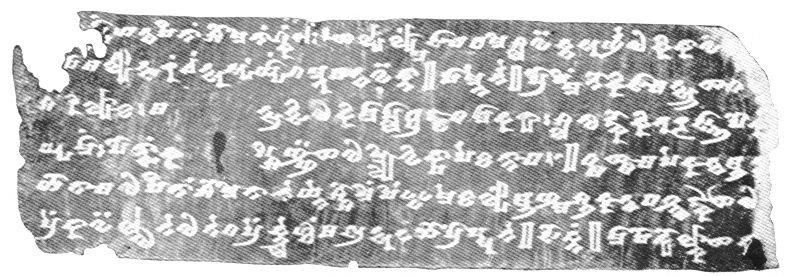
Fig .: Tocharian font
[Source: Jensen, Hans <1884 ->: The document in the past and present. - 3rd, neubearb. and exp. Ed. - Berlin <East>: German Verl of Sciences, 1969. - Figure 349]..
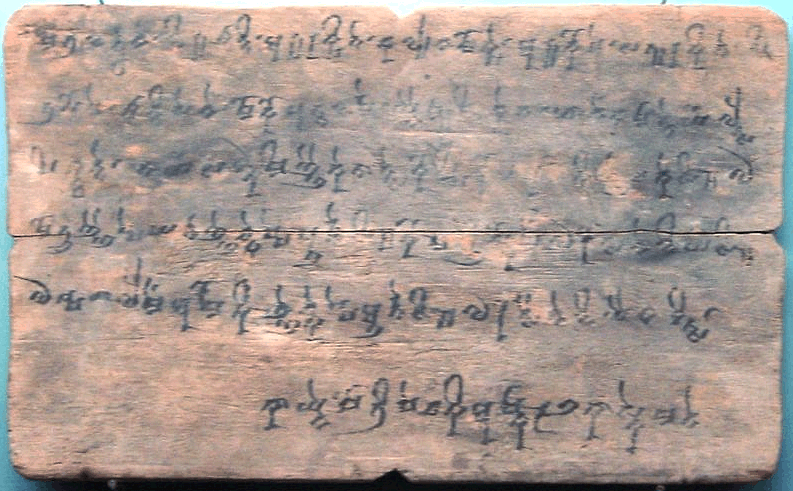
Fig .: wooden tablets with Tocharian Scripture Kucha (庫車), China, 5 /. 8 Century AD..
[Source: Wikipedia]
http://www.payer.de/exegese/exeg03.htm#5.2.1.
